Evolution of Energy Landscapes: A Regional Case Study in the Western Netherlands
Abstract
1. Introduction
2. Conceptual Framework
2.1. Historical Energy Periods
2.2. General Types of Energy Sources and Landscapes Distinguished in the Literature
2.3. Characterization of Energy Landscapes
3. Methods and Materials
3.1. Research Design and Methods
3.2. Introduction Case Study Region
4. Results: Evolution of Energy Landscapes in the Western Netherlands
4.1. The First Energy Period: Wood Energy
4.2. The Second Energy Period: Peat Energy
4.3. The Third Energy Period: Wind Energy
4.4. The Fourth Energy Period: Fossil Fuels
4.5. The Fifth Energy Period: Modern Renewables
5. Discussion and Conclusions
Supplementary Materials
Author Contributions
Funding
Acknowledgments
Conflicts of Interest
Appendix A
| Energy Sources in Literature | Studied Publications | Energy Landscape if Explicitly Named | |||||||||||||||||||||||||||||||||||||||||
|---|---|---|---|---|---|---|---|---|---|---|---|---|---|---|---|---|---|---|---|---|---|---|---|---|---|---|---|---|---|---|---|---|---|---|---|---|---|---|---|---|---|---|---|
| Books | Peer-Reviewed Articles | Grey Literature | |||||||||||||||||||||||||||||||||||||||||
| [84] | [95] | [96] | [11] | [57] | [3] | [18] | [19] | [97] | [98] | [99] | [100] | [49] | [15] | [6] | [58] | [5] | [2] | [4] | [27] | [101] | [16] | [14] | [102] | [20] | [22] | [21] | [25] | [103] | [104] | [105] | [106] | [107] | [108] | [109] | [110] | [28] | [111] | [112] | [113] | ||||
| Muscle power | Draft animals | X | X | X | X | X | X | X | X | X | |||||||||||||||||||||||||||||||||
| Human labour | X | X | X | X | X | X | X | X | X | X | |||||||||||||||||||||||||||||||||
| Biomass energy | Wood | Firewood | X | X | X | X | X | X | X | X | X | X | X | X | X | X | X | X | X | X | X | Y | X | X | X | X | X | Biomass landscape [25] | |||||||||||||||
| Charcoal | X | X | X | ||||||||||||||||||||||||||||||||||||||||
| Peat | Hoogveen * | X | X | X | X | X | X | X | X | X | Y | X | X | X | Peat energy landscape [25] | ||||||||||||||||||||||||||||
| Laagveen # | X | X | X | X | X | X | X | X | X | ||||||||||||||||||||||||||||||||||
| Energy crops | X | X | Y | X | X | X | X | X | X | X | X | X | X | X | X | X | X | X | X | Bioenergy landscape [3] | |||||||||||||||||||||||
| Waste | Solid | X | X | X | X | X | X | X | X | X | X | X | |||||||||||||||||||||||||||||||
| Liquid | X | X | X | X | X | X | X | ||||||||||||||||||||||||||||||||||||
| Gaseous | X | X | X | X | X | X | |||||||||||||||||||||||||||||||||||||
| Alcohol fuels | X | X | X | X | X | X | X | ||||||||||||||||||||||||||||||||||||
| Wind energy | Wind mills | X | X | X | X | X | X | X | X | X | X | Y | X | X | X | X | Wind energy landscape [25] | ||||||||||||||||||||||||||
| Wind turbines | X | X | X | Y | X | X | X | X | X | X | X | X | X | X | X | X | Y | Y | X | X | X | X | X | X | Wind power landscape [3,20]; Wind energy landscape [25] | ||||||||||||||||||
| Water energy | Water mills | X | X | X | X | X | X | X | X | X | |||||||||||||||||||||||||||||||||
| Hydropower | X | X | X | Y | X | X | X | X | X | X | X | X | X | X | Y | Y | Y | X | X | X | Hydropower landscape [3,21,25,102] | ||||||||||||||||||||||
| Blue energy | X | X | X | X | X | X | X | X | |||||||||||||||||||||||||||||||||||
| Solar energy | Direct heat | X | X | X | X | X | X | X | X | X | X | X | X | X | Y | X | X | Solar energy landscape [25] | |||||||||||||||||||||||||
| Photovoltaics | X | X | X | Y | X | X | X | X | X | X | X | X | X | X | X | X | Y | X | X | X | X | X | X | Solar power landscape [3]; Solar energy landscape [25] | |||||||||||||||||||
| Heat cold storage | X | X | X | X | X | ||||||||||||||||||||||||||||||||||||||
| Thermal energy | Deep geothermal heat | X | X | X | X | X | X | X | X | X | X | X | X | Y | X | X | X | Geothermal energy landscape [25] | |||||||||||||||||||||||||
| Fossil fuels | Conventional fossils | Coal | X | X | X | X | X | X | X | X | X | X | X | X | X | X | X | X | X | X | X | X | X | Coal energy landscape [25] | |||||||||||||||||||
| Naturalgas | X | X | X | X | X | X | X | X | X | X | X | X | X | X | Y | X | X | X | Y | X | X | X | Natural gas production landscape [109]; Natural gas energy landscape [25] | ||||||||||||||||||||
| Shalegas | X | ||||||||||||||||||||||||||||||||||||||||||
| Oil i.e., petroleum | X | X | X | X | X | X | Y | X | X | X | X | X | X | X | X | Y | X | X | X | X | Petroleum landscape [100]; Oil energy landscape [25] | ||||||||||||||||||||||
| Whaleoil | X | ||||||||||||||||||||||||||||||||||||||||||
| Unconv. fossils | Tarsands | Y | Unconventional fossil fuel landscape [25] | ||||||||||||||||||||||||||||||||||||||||
| Coal-bedmethane | Y | Unconventional fossil fuel landscape [25] | |||||||||||||||||||||||||||||||||||||||||
| Nuclear energy | X | X | X | X | X | X | X | X | X | X | X | X | X | Y | X | X | X | X | Nuclear energy landscape [25] | ||||||||||||||||||||||||
| Various energy sources | Electricity generation | X | X | X | X | X | X | X | X | X | X | X | X | ||||||||||||||||||||||||||||||
| Transport/transmission | X | X | X | X | X | X | X | X | X | ||||||||||||||||||||||||||||||||||
| Total number of subtypes mentioned per publication | 4 | 9 | 12 | 4 | 10 | 4 | 17 | 12 | 14 | 16 | 11 | 12 | 20 | 2 | 16 | 13 | 5 | 18 | 8 | 4 | 6 | 14 | 16 | 13 | 1 | 1 | 2 | 13 | 5 | 9 | 13 | 1 | 1 | 2 | 1 | 14 | 14 | 3 | 11 | 7 | |||
| Total number of main energy sources mentioned | 3 | 4 | 4 | 4 | 5 | 4 | 8 | 7 | 6 | 8 | 7 | 8 | 9 | 1 | 8 | 5 | 4 | 8 | 6 | 3 | 3 | 7 | 7 | 6 | 1 | 1 | 2 | 7 | 5 | 7 | 7 | 1 | 1 | 1 | 1 | 6 | 8 | 2 | 6 | 4 | |||
References
- Roddis, P.; Carver, S.; Dallimer, M.; Ziv, G. Accounting for taste? Analysing diverging public support for energy sources in great britain. Energy Res. Soc. Sci. 2019, 56, 101226. [Google Scholar] [CrossRef]
- Sijmons, D.; Hugtenburg, J.; van Hoorn, A.; Feddes, F. Landscape and Energy—Designing Transition; NAI Uitgevers: Rotterdam, The Nederlands, 2014. [Google Scholar]
- Frolova, M.; Prados, M.J.; Nadai, A. (Eds.) Renewable Energies and European Landscapes—Lessons from Southern European Cases; Springer: Dordrecht, The Netherlands, 2015. [Google Scholar]
- Smil, V. Energy in World History; Westview Press: Boulder, CO, USA, 1994. [Google Scholar]
- Sieferle, R.P. The Subterranean Forest—Energy Systems and the Industrial Revolution; Cambridge—The White Horse Press: Cambridgeshire, UK, 2001. [Google Scholar]
- Pasqualetti, M.J. Reading the changing energy landscape. In Sustainable Energy Landscapes—Designing, Planning and Development; Stremke, S., van den Dobbelsteen, A., Eds.; CRC Press: Boca Raton, FL, USA, 2013. [Google Scholar]
- van der Horst, D. Energy landscapes of less than two-degree global warming. In Handbook on the Geographies of Energy; Solomon, B., Calvert, K., Eds.; Edward Elgar Publishing: Northampton, UK, 2017. [Google Scholar]
- Solomon, B.; Calvert, K. Introduction: Energy and the geographical traditions. In Handbook on the Geographies of Energy; Solomon, B., Calvert, K., Eds.; Edward Elgar Publishing: Northampton, UK, 2017. [Google Scholar]
- Geels, F.; Berkhout, F.; van Vuuren, D. Bridging analytical approaches for low-carbon transitions. Nat. Clim. Chang. 2016, 6, 576–583. [Google Scholar] [CrossRef]
- Intergovermental Panel on Climate Change (IPCC). Special Report on Renewable Energy Sources and Climate Change Mitigation; Cambrige University Press: Cambridge, UK; New York, NY, USA, 2011. [Google Scholar]
- Crowe, S. The Landscape of Power; The Architectural Press: London, UK, 1958. [Google Scholar]
- Antrop, M. Why landscapes of the past are important for the future. Landsc. Urban Plann. 2005, 70, 21–34. [Google Scholar] [CrossRef]
- Kuitert, W. Urban landscape systems understood by geo-history map overlay. J. Landsc. Architec. 2013, 8, 54–63. [Google Scholar] [CrossRef]
- Verbong, G.; van Selm, A.; Knoppers, R.; Raven, R. Een Kwestie van Lange Adem—De Geschiedenis van Duurzame Energie in Nederland; Aeneas: Boxtel, The Netherlands, 2001. [Google Scholar]
- Noorman, K.; de Roo, G. (Eds.) Energielandschappen—de 3de Generatie [Energy Landscapes, the 3rd Generation]; Provincie Drenthe: Assen, The Netherlands, 2011. [Google Scholar]
- van Kann, F.M.G. Energie en Ruimtelijke Planning—Een Spannende Combinatie. Ph.D. Thesis, University of Groningen, Groningen, The Netherlands, 2015. [Google Scholar]
- Blaschke, T.; Biberacher, M.; Gadocha, S.; Schardinger, I. Energy landscapes—Meeting energy demands and human aspirations. Biom. Bioenerg. 2013, 55, 3–16. [Google Scholar] [CrossRef]
- Gordijn, H.; Verwest, F.; van Hoorn, A. Energie is Ruimte; Ruimtelijk Planbureau: Den Haag, The Netherlands, 2003. [Google Scholar]
- Goshn, R. (Ed.) Landscapes of Energy; Harvard University Press: Cambridge, MA, USA, 2019. [Google Scholar]
- Lambussiere, O.; Nadai, A. Unexpected wind power potentials. The art of planning with inherited socio-geographical configurations (France). Scottish Geograp. J. 2014, 130, 152–167. [Google Scholar] [CrossRef]
- Nadai, A.; van der Horst, D. Introduction—Landscape of energies. Landsc. Res. 2010, 35, 143–155. [Google Scholar] [CrossRef]
- Maxwell, K. Beyond verticality—Fuelscape politics and practices in the Andes. Human Ecol. 2011, 39, 465–478. [Google Scholar] [CrossRef]
- Stremke, S. Sustainable Energy Landscape: Implementing energy transition in the physical realm. Encycl. Environ. Manag. 2015. [Google Scholar] [CrossRef]
- Selman, P. Learning to love the landscapes of carbon-neutrality. Landsc. Res. 2010, 35, 157–171. [Google Scholar] [CrossRef]
- Pasqualetti, M.J.; Stremke, S. Energy landscapes in a crowded world: A first typology of origins and expressions. Energ. Res. Soc. Sci. 2018, 36, 94–105. [Google Scholar] [CrossRef]
- Rotmans, J.; Kemp, R.; van Asselt, M. More evolution than revolution: Transition management in public policy. Foresight 2001, 3, 15–31. [Google Scholar] [CrossRef]
- Smil, V. Power Density—A Key to Understanding Energy Sources and Uses; The MIT Press: Cambridge, MA, USA, 2015. [Google Scholar]
- Rijksdienst voor Cultureel Erfgoed (RCE). Handreiking Energie, Erfgoed en Ruimte; RCE: Amersfoort, The Netherlands, 2016. [Google Scholar]
- Directie Kennis en Innovatie Ontgonnen Verleden: Hoofdstuk 18 Landschap 6: Laagveengebied. Available online: http://edepot.wur.nl/146359 (accessed on 20 July 2017).
- Devine-Wright, P. Explaining ‘NIMBY’ objections to a power line—The role of personal, place attachment and project-related factors. Environ. Behav. 2012, 45, 761–781. [Google Scholar] [CrossRef]
- Leenaers, H.; Camarasa, M. De Bosatlas van de Energie; Noordhoff Uitgevers: Groningen, The Netherlands, 2012. [Google Scholar]
- Frolova, M.; Centeri, C.; Benediktsson, K.; Hunziker, M.; Kabai, R.; Scognamiglio, A.; Martinopoulos, G.; Sismani, G.; Brito, P.; Cerón, E.M.; et al. Effects of renewable energy on landscape in Europe: Comparison of hydro, wind, solar, bio-, geothermal and infrastructure energy landscapes. Hung. Geogr. Bull. 2019, 68, 317–339. [Google Scholar] [CrossRef]
- Calvert, K.; Greer, K.; Maddison-MacFadyen, M. Theorizing energy landscapes for energy transition management: Insights from a socioecological history of energy transitions in Bermuda. Geoforum 2019, 102, 191–201. [Google Scholar] [CrossRef]
- ‘Kinderdijk Before a Storm’. Uploaded by Roman Boed, 16 July 2015. Licensed under a Creative Commons 2.0 License. The Original Photo is Slightly Cropped. Available online: https://www.flickr.com/photos/romanboed/19916318502 (accessed on 21 July 2017).
- ‘Staatsmijn MauritsxLutterade’. Uploaded by PK, 3 November 2013. Licensed under a Creative Commons 2.0 License. The Original Photo is Slightly Cropped. Available online: https://www.flickr.com/photos/uair01/10646574825 (accessed on 21 July 2017).
- Het Fochteloërveen—Hoogveengebied op de Grens van Groningen en Friesland’. Author: Gouwenaar, 21 May 2008. Licensed under Wikimedia Commons, Public Domain. Available online: https://nl.wikipedia.org/wiki/Bestand:Fochtloerveen.jpg (accessed on 21 July 2017).
- Creswell, J.W. Research Design—Qualitative, Quantitative, and Mixed Methods Approaches; SAGE: Thousand Oaks, CA, USA, 2014. [Google Scholar]
- Yin, R.K. Case Study Research—Design and Methods; SAGE: Thousand Oaks, CA, USA, 2014. [Google Scholar]
- Flyvbjerg, B. Five Misunderstandings about Case-Study Research. Qual. Inq. 2006, 12, 219–245. [Google Scholar] [CrossRef]
- Johnson, K.E.; Stake, R.E. The Art of Case Study Research. Mod. Lang. J. 1996, 80, 556. [Google Scholar] [CrossRef]
- Yin, R.K. Applications of Case Study Research; SAGE: Thousand Oaks, CA, USA, 2012. [Google Scholar]
- Deming, M.E.; Swaffield, S. Landscape Research; Inquiry, Strategy Design Wiley: Hoboken, NJ, USA, 2011. [Google Scholar]
- Picuno, P.; Cillis, G.; Statuto, D. Investigating the time evolution of a rural landscape: How historical maps may provide environmental information when processed using a GIS. Ecol. Eng. 2019, 139, 105580. [Google Scholar] [CrossRef]
- Hesse-Biber, S.; Leavy, P. Distinguishing qualitative research. In Approaches to Qualitative Research—A Reader on Theory and Practice; Hesse-Biber, S.N., Leavy, P., Eds.; Oxford University Press: New York, NY, USA, 2004. [Google Scholar]
- Tan, F.B.; Hunter, M.G. The Repertory Grid Technique: A Method for the Study of Cognition in Information Systems. MIS Q. 2002, 26, 39. [Google Scholar] [CrossRef]
- Vos, P.; de Vries, S. 2e Generatie Palaeogeografische Kaarten van Nederland. Del-tares, Utrecht. Available online: https://www.noviomagus.info/ontoegankelijk.htm (accessed on 25 July 2017).
- Borger, G.; Horsten, H.F.; Engel, R.; Rutte, O.; Diesfeldt, I.; Pané, A. Twaalf eeuwen ruimtelijke transformatie in het westen van Nederland in zes kaartbeelden: Landschap, bewoning en infrastructuur in 800, 1200, 1500, 1700, 1900 en 2000. In OverHolland; Sun Publisher: Amsterdam, The Netherlands, 2011; pp. 4–124. [Google Scholar]
- RCE. Droogmakerijen met molens en gemalen. GIS-File Unpublished work. 2017. [Google Scholar]
- Cranfield, I.; Ormeling, F.J.; Schulze, H.; Fullard, H.; Darby, H.C. De Grote Bosatlas. Geogr. J. 1978, 144, 371. [Google Scholar] [CrossRef]
- van den Kerkhoff, J. Urban Use of Peat Soils. Peat Lands Lying below Sea Level in the Western Part of the Netherlands, Their Geology, Reclamation, Soils, Management, and Land Use. Available online: http://edepot.wur.nl/74512 (accessed on 20 July 2017).
- ‘Winterlandschap’. Paul Bril after Aegidius Sadeler. Licensed under a Creative Commons Public Domain Mark 1.0 License. Available online: https://www.europeana.eu/portal/nl/record/90402/SK_A_2672.html (accessed on 14 July 2019).
- ‘Peat Dragging in Holland, ca. 1800’. Author Unknown. Available online: https://nl.wikipedia.org/wiki/Bestand:Veenderij_Turfwinning.jpg (accessed on 21 July 2017).
- ‘Nieuwkoopse Plassen’. Photo by Jan Arkesteijn. Licensed under Wikimedia Commons, Public Domain. Available online: https://commons.wikimedia.org/wiki/File:Nieuwkoopse_Plassen_20070721.jpg (accessed on 21 July 2017).
- ‘Haarlemmermeerpolder’. Photo by Ilonamay, February 3, 2017. Licensed Under a Creative Commons License ShareAlike 3.0 Unported License. Available online: https://nl.wikipedia.org/wiki/Bestand:Haarlemmermeerpolder.jpg (accessed on 21 July 2017).
- Smil, V. Energy in Nature and Society: General Energetics of Complex Systems; MIT Press: Cambridge, MA, USA, 2008. [Google Scholar]
- Bridge, G.; Bouzarovski, S.; Bradshaw, M.; Eyre, N. Geographies of energy transition: Space, place, and the low-carbon economy. Energy Policy 2013, 53, 331–340. [Google Scholar] [CrossRef]
- Debeir, J.C.; Deléage, J.P.; Hémery, D. In the Servitude of Power—Energy and Civilization through the Ages; Zed Books: London, UK, 1991. [Google Scholar]
- Pimentel, D.; Pimentel, M.H. Food, Energy and Society; CRC Press: Boca Raton, FL, USA, 2008. [Google Scholar]
- Hausrath, H. Der Deutsche Wald: Aus Natur und Geisteswelt; Teubner: Leipzig, Germany, 1907. [Google Scholar]
- Mitscherlich, G. Zustand, Wachstum und Nutzung des Waldes im Wandel der Zeit; Hans Ferdinand Schulz: Freiburg, Germany, 1963. [Google Scholar]
- van Dam, P.J.E.M. Vissen in Veenmeren De sluisvisserij op aal tussen Haarlem en Amsterdam en de Ecologische Transformatie van Rijnland 1440–1530; Uitgeverij Verloren: Hilversum, The Netherlands, 1998. [Google Scholar]
- Bostock, J.; Riley, H.T. The Natural History of Pliny (Translation into English); Bohn: London, UK, 1885. [Google Scholar]
- Cultureelerfgoed.nl. Landschap 6–Laagveengebied. Available online: https://studylibnl.com/doc/982735/18-landschap-6--laagveengebied---rijksdienst-voor-het-cul (accessed on 18 July 2017).
- Cornelisse, C.H. The Economy of Peat and its Environmental Consequences in Holland during the Late Middle Ages. In Jaarboek voor Ecologische Geschiedenis 2005–2006; Academia Press: Gent, Belgium, 2006; pp. 95–122. [Google Scholar]
- Unger, R.W. Energy Sources for the Dutch Golden Age—Peat, Wind, and Coal. Res. Econ. Hist. 1984, 9, 221–253. [Google Scholar]
- Jongepier, I.; Soens, T.; Thoen, E.; Eetvelde, V.; Crombé, P.; Bats, M. The brown gold: A reappraisal of medieval peat marshes in Northern Flanders (Belgium). Water Hist. 2011, 3, 73–93. [Google Scholar] [CrossRef]
- Geologievannederland.nl. Veenbodem. Available online: http://www.geologievannederland.nl/ondergrond/bodems/veenbodem-veenlandschap (accessed on 20 July 2017).
- Karel, E. Colonizing peatlands. Transformation or deformation of peat areas in the Netherlands 1000–2000. In Proceedings of the Circulating Natures: Water-Food-Energy of the European Society for Environmental History (ESEH), Munich, Germany, 20–24 August 2013. [Google Scholar]
- Nassi, O.; di Nasso, N.; Guidi, W.; Ragaglini, G.; Tozzini, C.; Bonari, E. Biomass production and energy balance of a 12-year-old short-rotation coppice poplar stand under different cutting cycles. Glob. Chang. Biol. Bioenergy 2010, 2, 89–97. [Google Scholar] [CrossRef]
- Chmielniak, T.; Ściążko, M. Co-gasification of biomass and coal for methanol synthesis. Appl. Energy 2003, 74, 393–403. [Google Scholar] [CrossRef]
- Low-Tech Magazine. What is the Energy Density of Peat or Turf? Available online: http://www.lowtechmagazine.com/whats-the-energy-density-of-peat-or-turf-.html (accessed on 25 July 2017).
- Kosian, M. Droogmakerijen. Rijksdienst voor Cultureel Erfgoed. Available online: https://landschapinnederland.nl/sites/default/files/map_attachments/104263_Droogmakerijen_PDFA.pdf (accessed on 20 July 2017).
- Alterra. Neder-Landschap Internationaal; Bouwstenen voor een Selectie van Gebieden voor Landschapsbehoud [Dutch-Landscape International: Building Blocks for a Selection of Areas for Landscape Preservation]; Alterra: Wageningen, The Netherlands, 2011. [Google Scholar]
- Baart, T. Energielandschappen een Fotografische Nulmeting; College van Rijksadviseurs, CRA: Den Hague, The Netherlands, 2014. [Google Scholar]
- CLO (Compendium voor de Leefomgeving). Nationaal Landschap Groene Hart. Available online: https://www.clo.nl/indicatoren/nl1489-groene-hart (accessed on 23 November 2016).
- Polders! Gedicht Nederland; Geuze, A., Feddes, F., Eds.; NAi Uitgevers: Rotterdam, The Netherlands, 2005. [Google Scholar]
- Erfgoedhuis Zuid-Holland. Geschiedenis van Zuid-Holland. De Eerste Molens en Het Gebruik Van Wind. Available online: https://geschiedenisvanzuidholland.nl/verhalen/de-eerste-molens-en-het-gebruik-van-wind (accessed on 20 July 2017).
- Provincie Zuid-Holland. Beleidsvisie Cultureel Erfgoed en Basisvoorzieningen Cultuur. Available online: https://www.zuid-holland.nl/publish/pages/16697/beleidsvisiecultureelerfgoed2017-2020.pdf (accessed on 20 July 2017).
- van Deukeren, H. Jaarboek Oud-Utrecht; Oud-Utrecht: Utrecht, The Netherlands, 1991; pp. 143–172, ISSN 0923-7046. [Google Scholar]
- CLO (Compendium voor de Leefomgeving). Windturbines op Land en op Zee 1990–2016. Available online: https://www.clo.nl/indicatoren/nl1475-windturbines-in-de-groene-ruimte (accessed on 7 August 2018).
- RVO. Monitor Wind op Land 2018, 6th ed.; Rijksdienst voor Ondernemend Nederland: Den Haag, The Netherlands, 2019. [Google Scholar]
- van Rijn, B. Beleidskaders zon-pv. Inventarisatie en Analyse. i.o.v. Min. EZK; Klimaatbeleid: Een Handelingsperspectief voor Gemeenten; Faculteit der Managementwetenschappen: Nijmegen, The Netherlands, 2019. [Google Scholar]
- Sijmons, D.; Frijters, E.; Wijnakker, R.; Hugtenburg, J.; Stremke, S.; Hocks, B.; Vermeulen, M.; Gerretsen, P. Energie & Ruimte [Energy & Space]; Deltametropool: Den Hague, The Netherlands, 2019. [Google Scholar]
- Apostol, D.; Palmer, J.; Pasqualetti, M.; Smardon, R.; Sullivan, R. The Renewable Energy Landscape: Preserving Scenic Values in our Sustainable Future. Routledge: New York, NY, USA, 2016. [Google Scholar]
- Hui, A.; Day, R.; Walker, G.P. Identifying Research Strategies and Methodological Priorities for the Study of Demanding Energy. In Demanding Energy; Springer Science and Business Media LLC: New York, NY, USA, 2017; pp. 341–354. [Google Scholar]
- Harrison, C. The historical–geographical construction of power: Electricity in Eastern North Carolina. Local Environ. 2013, 18, 469–486. [Google Scholar] [CrossRef]
- Murray, S. The energyscape of the lower Thames and Medway: Britain’s changing patterns of energy use. Landsc. Hist. 2020, 41, 99–120. [Google Scholar] [CrossRef]
- San-Antonio-Gómez, C.; Velilla, C.; Manzano-Agugliaro, F. Urban and landscape changes through historical maps: The Real Sitio of Aranjuez (1775–2005), a case study. Comput. Environ. Urban Syst. 2014, 44, 47–58. [Google Scholar] [CrossRef]
- Lewellyn, D.H.; Rohse, M.; Bere, J.; Lewis, K.; Fyfe, H. Transforming landscapes and identities in the south Wales valleys. Landsc. Res. 2017, 44, 804–821. [Google Scholar] [CrossRef]
- Sovacool, B.K. What are we doing here? Analyzing fifteen years of energy scholarship and proposing a social science research agenda. Energy Res. Soc. Sci. 2014, 1, 1–29. [Google Scholar] [CrossRef]
- Kumar, R. Research Methodology—A Step-by-Step guide for Beginners; SAGE: Thousand Oaks, CA, USA, 2014. [Google Scholar]
- de Botton, A. The Pleasures and Sorrows of Work; Penguin books: London, UK, 2009. [Google Scholar]
- Rohse, M.; Day, R.; Llewellyn, D. Towards an emotional energy geography: Attending to emotions and affects in a former coal mining community in South Wales, UK. Geoforum 2020, 110, 136–146. [Google Scholar] [CrossRef]
- Sijmons, D.; van Dorst, M. Strong feelings: Emotional landscape of wind turbines. In Sustainable Energy Landscapes: Designing, Planning, and Development; Stremke, S., van den Dobbelsteen, A., Eds.; CRC Press: Boca Raton, FL, USA, 2012. [Google Scholar]
- Bade, E. Energielandschappen—Een Fotografische Nulmeting [Energy Landscapes–A Photographic Survey]; Office of the Dutch State Adviser for Landscape: Den Hague, The Netherlands, 2014. [Google Scholar]
- Bade, B.; Lardinois, R. Het Energielandschap [The Energy Landscape]; KNNU Uitgeverij: Zeist, The Netherlands, 2010. [Google Scholar]
- Ter-Haar, I.; Stijkel, A.; Westendorp, P.; Zomer, S. P-NUTS Lokale Duurzame Energie in Nederland [P-NUTS Local sustainable energy in The Netherlands]; NEWNRG: Amsterdam, The Netherlands, 2011. [Google Scholar]
- Kander, A.; Malanima, P.; Warde, P. Power to the People—Energy in Europe Over the Last Five Centuries; Princeton University Press: Princeton, NJ, USA, 2013. [Google Scholar]
- Mackay, D. Sustainable Energy—without the Hot Air; UIT Cambridge: Cambridge, UK, 2009. [Google Scholar]
- Margalit, H. Energy, Cities and Sustainability—An Historical Approach; Routledge: London, UK, 2016. [Google Scholar]
- Stremke, S. Designing Sustainable Energy Landscapes: Concepts, Principles and Procedures. Ph.D. Thesis, Wageningen University, Wageningen, The Netherlands, 2010. [Google Scholar]
- Howard, D.; Burgess, P.; Butler, S.; Carver, S.; Cockerill, T.; Coleby, A.; Gan, G.; Goodier, C.; van Der Horst, D.; Hubacek, K.; et al. Energyscapes: Linking the energy system and ecosystem services in real landscapes. Biomass Bioenergy 2013, 55, 17–26. [Google Scholar] [CrossRef]
- Soini, K.; Pouta, E.; Salmiovirta, M.; Uusitalo, M.; Kivinen, T. Residents’ perceptions of energy landscape: The case of transmission lines. Land Use Policy 2011, 28, 294–305. [Google Scholar] [CrossRef]
- Knoot, R.; de Waal, R. Brown Coal Mining and Rehabilitation: A Landscape Chronicle. Master’s. Thesis, Wageningen University, Wageningen, The Netherlands, 2009. [Google Scholar]
- DGGL. Energielandschaften Geschichte und Zukunft der Landnutzung [Energy landscapes—History and Future of Land Use]; Callwey: Minhen, Germany, 2013. [Google Scholar]
- Feddes, Y. Windmolens hebben een Landschappelijk Verhaal Nodig [Wind Turbines Require a Landscape Narrative]; Office of the Dutch State Adviser for Landscape: Den Hague, The Netherlands, 2009. [Google Scholar]
- Feddes, Y. Een Choreografie Voor 1000 Molens [A choreography for 1000 wind turbines]; Office of the Dutch State Adviser for Landscape: Den Hague, The Netherlands, 2011. [Google Scholar]
- Oudes, D. Designing landscapes with high-voltage substations. Master’s Thesis, Wageningen University, Wageningen, The Netherlands, 2012. [Google Scholar]
- Peters, V. Recycling Energy Landscape: The Natural Gas Production Landscape of Groningen. Master’s Thesis, Wageningen University, Wageningen, The Netherlands, 2016. [Google Scholar]
- RCE (Rijksdienst voor Cultureel Erfgoed). Verkenning Energielandschappen en Erfgoed [Exploration of Energy Landscape and Heritage]; RCE: Amersfoort, The Netherlands, 2012. [Google Scholar]
- Snippert, T. Hidden Power: Veenkolonien 3.0. Master’s Thesis, Wageningen University, Wageningen, The Netherlands, 2012. [Google Scholar]
- Snippert, T. Hidden Power Nederland; College van Rijksadviseurs: Den Hague, The Netherlands, 2017. [Google Scholar]
- Straaten, T. Sustainable Energy Landscapes: Past, Present & Future. Master’s Thesis, Wageningen University, Wageningen, The Netherlands, 2012. [Google Scholar]
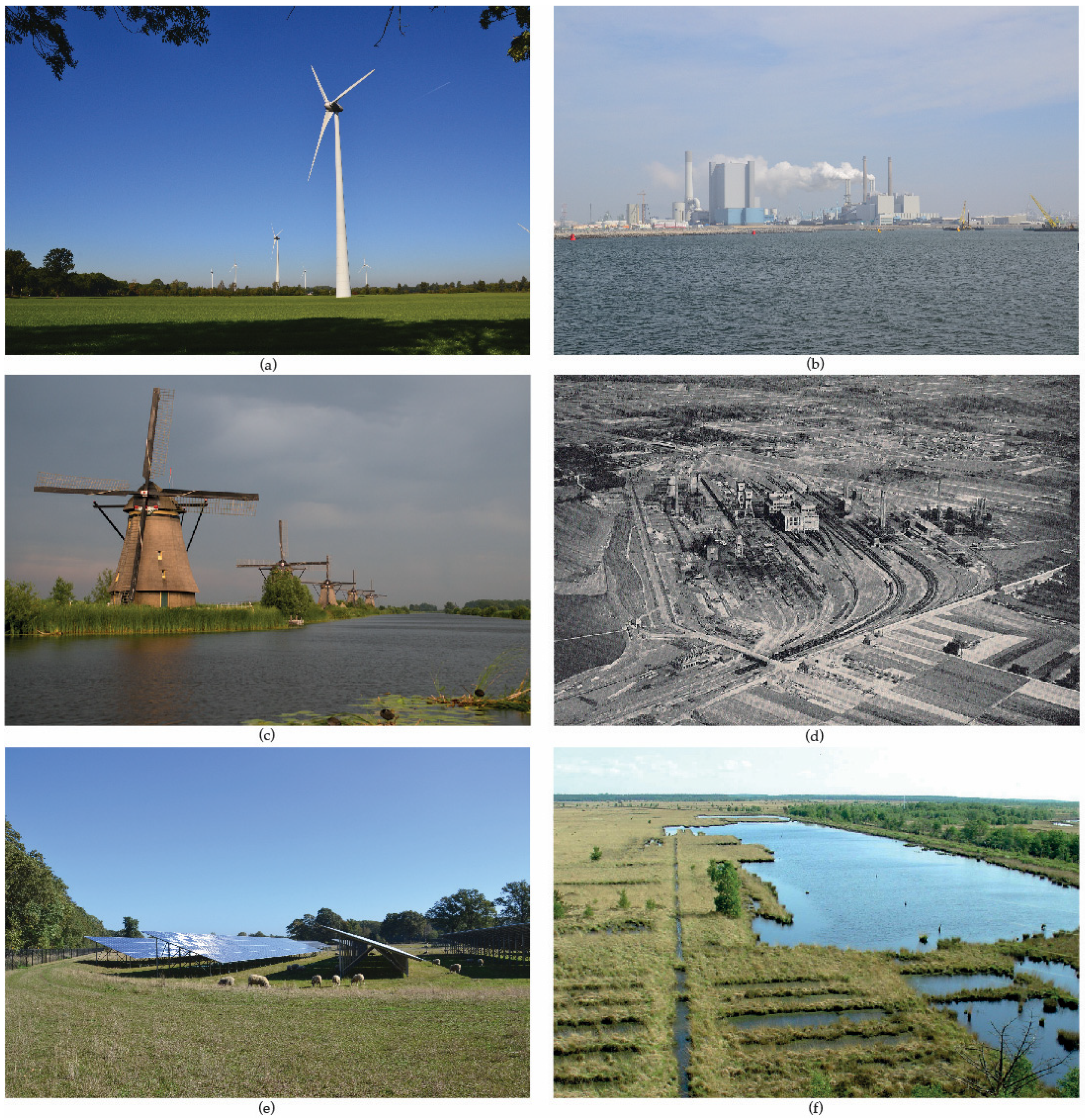
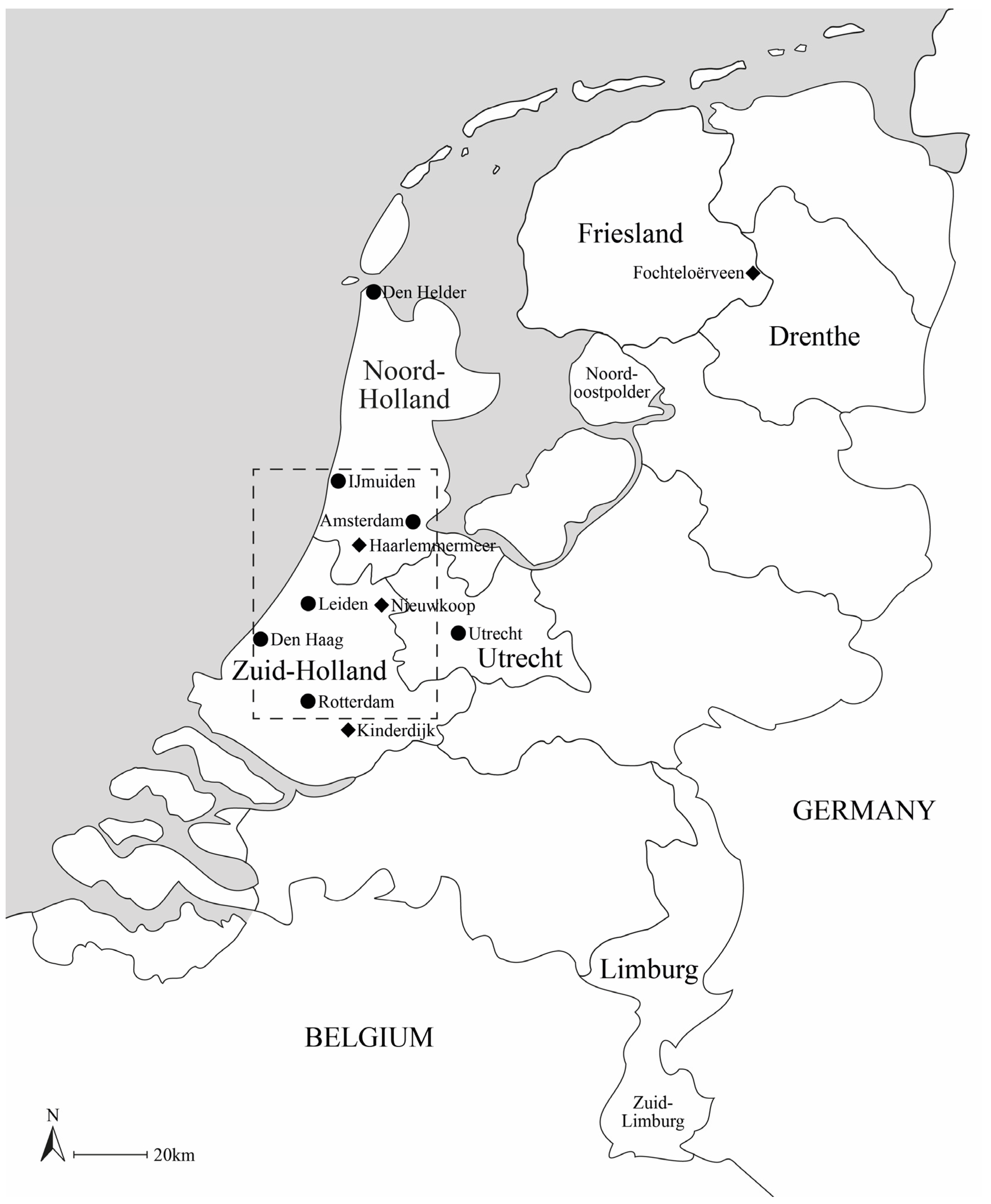
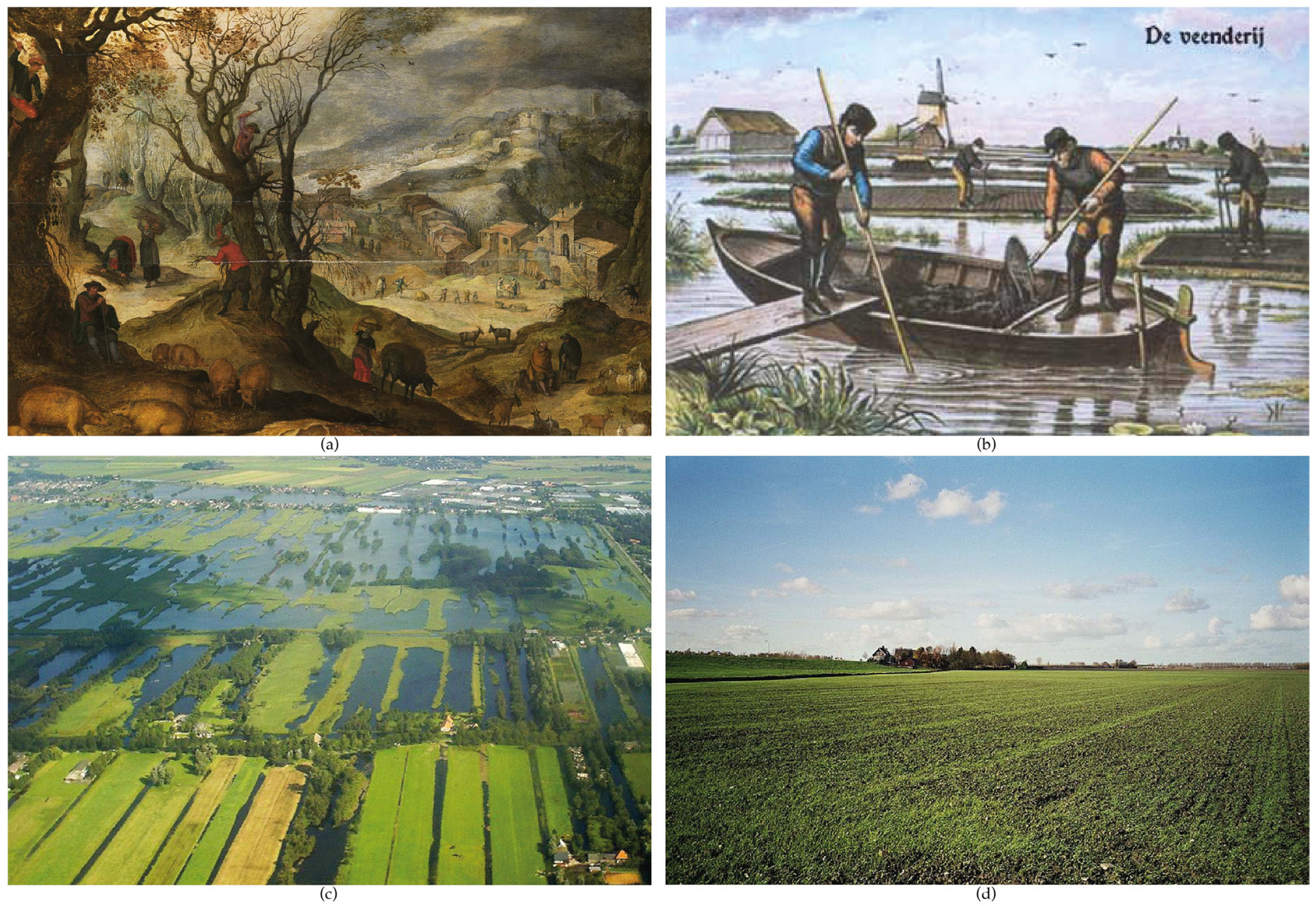
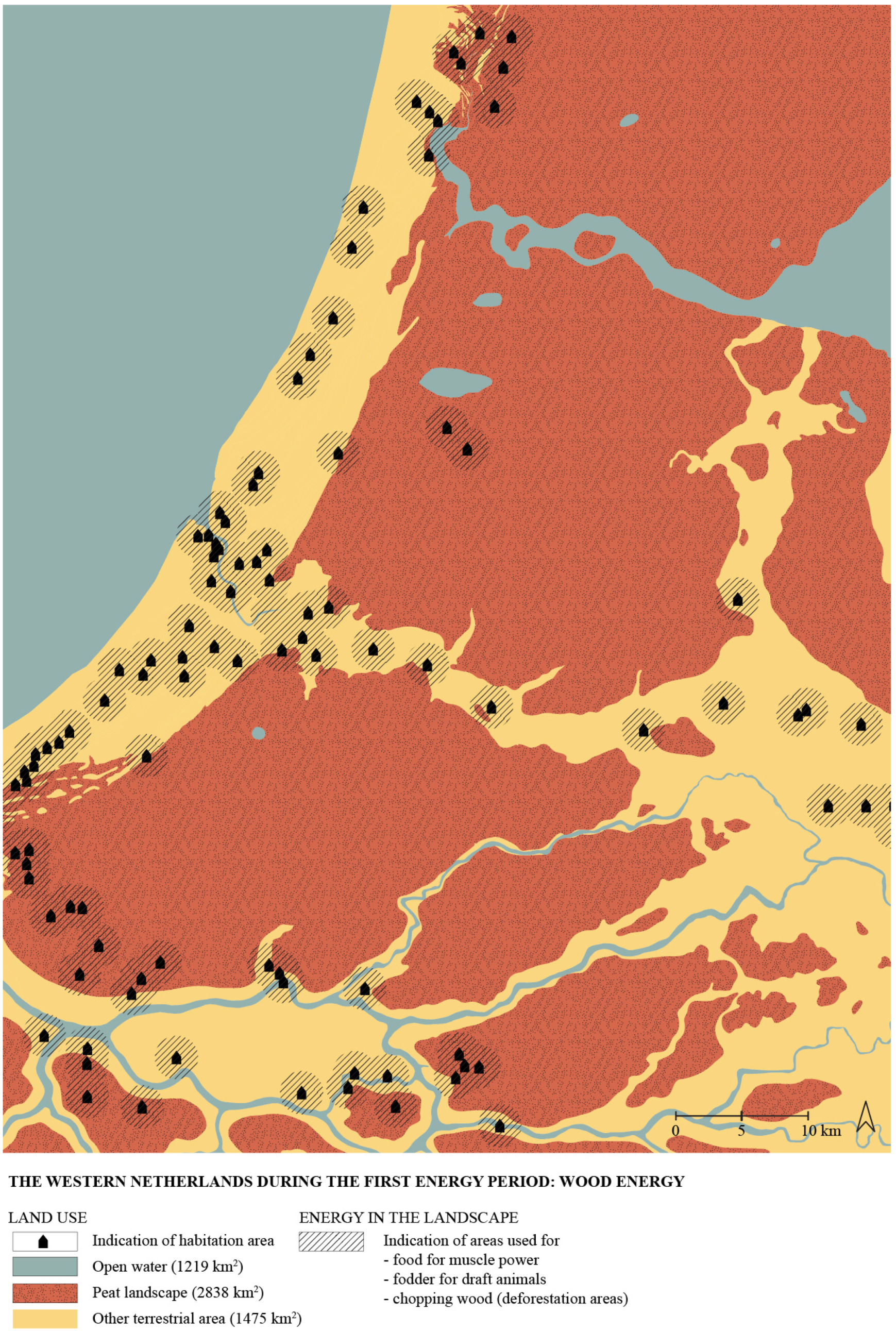
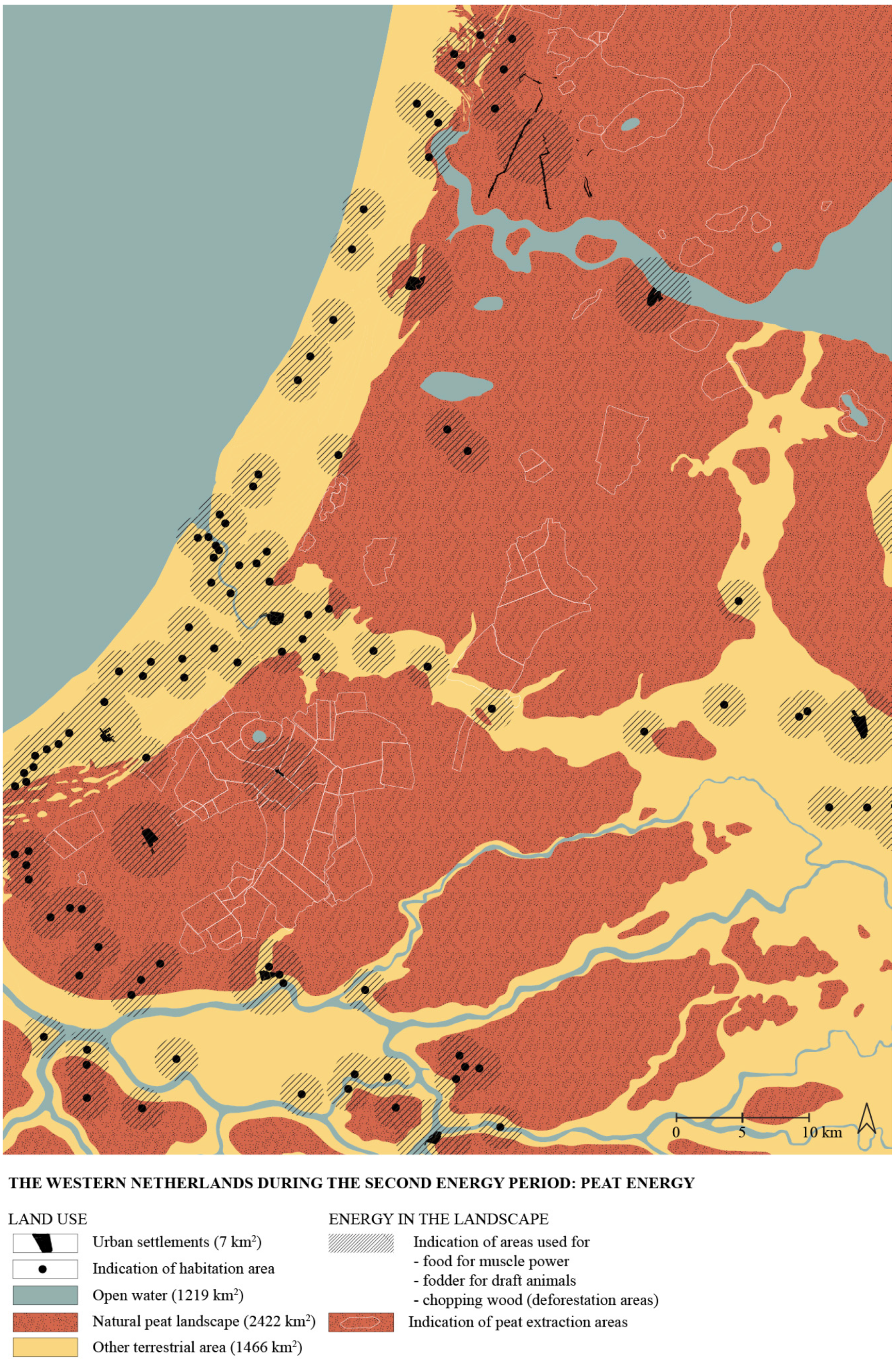

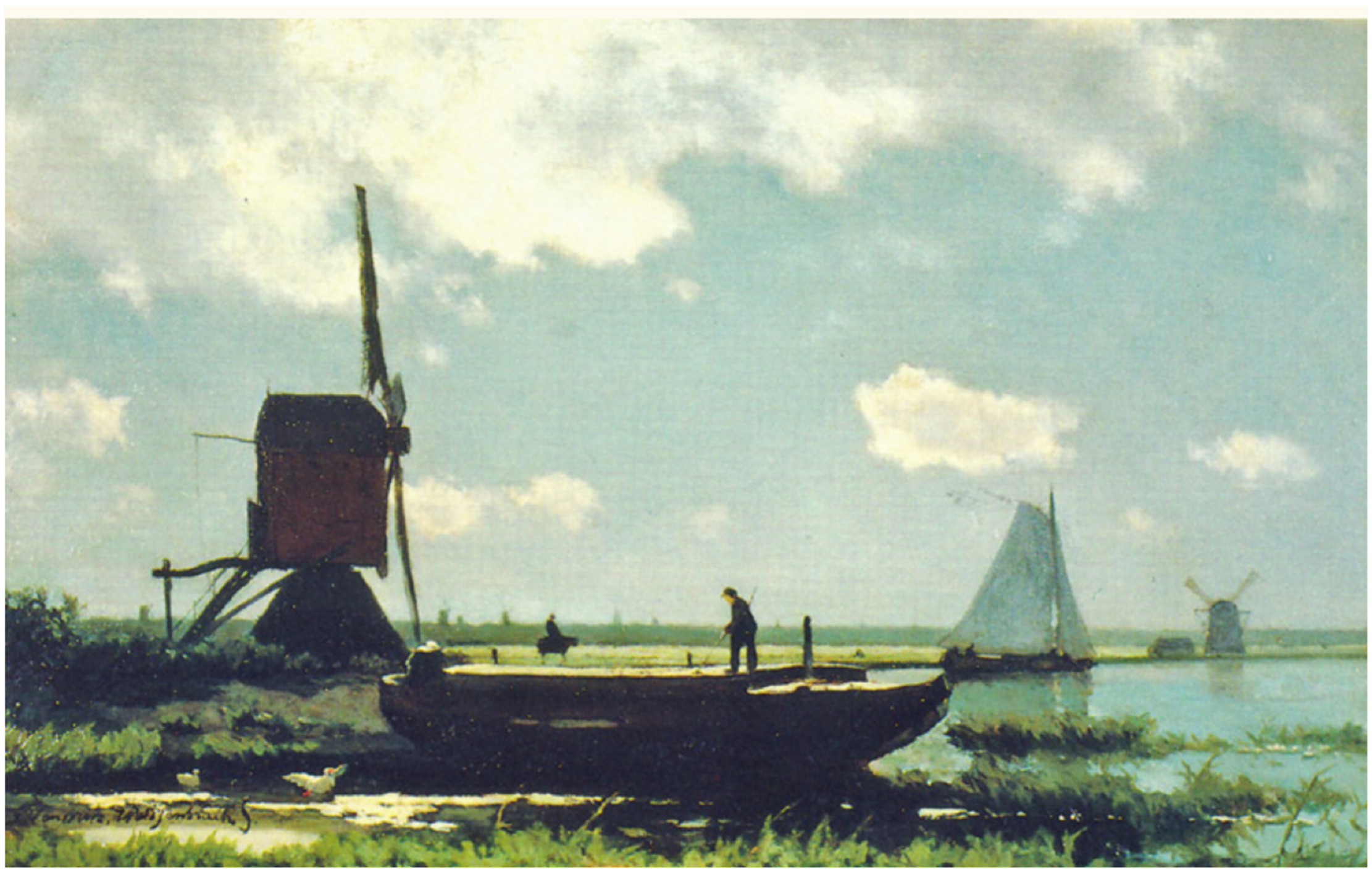
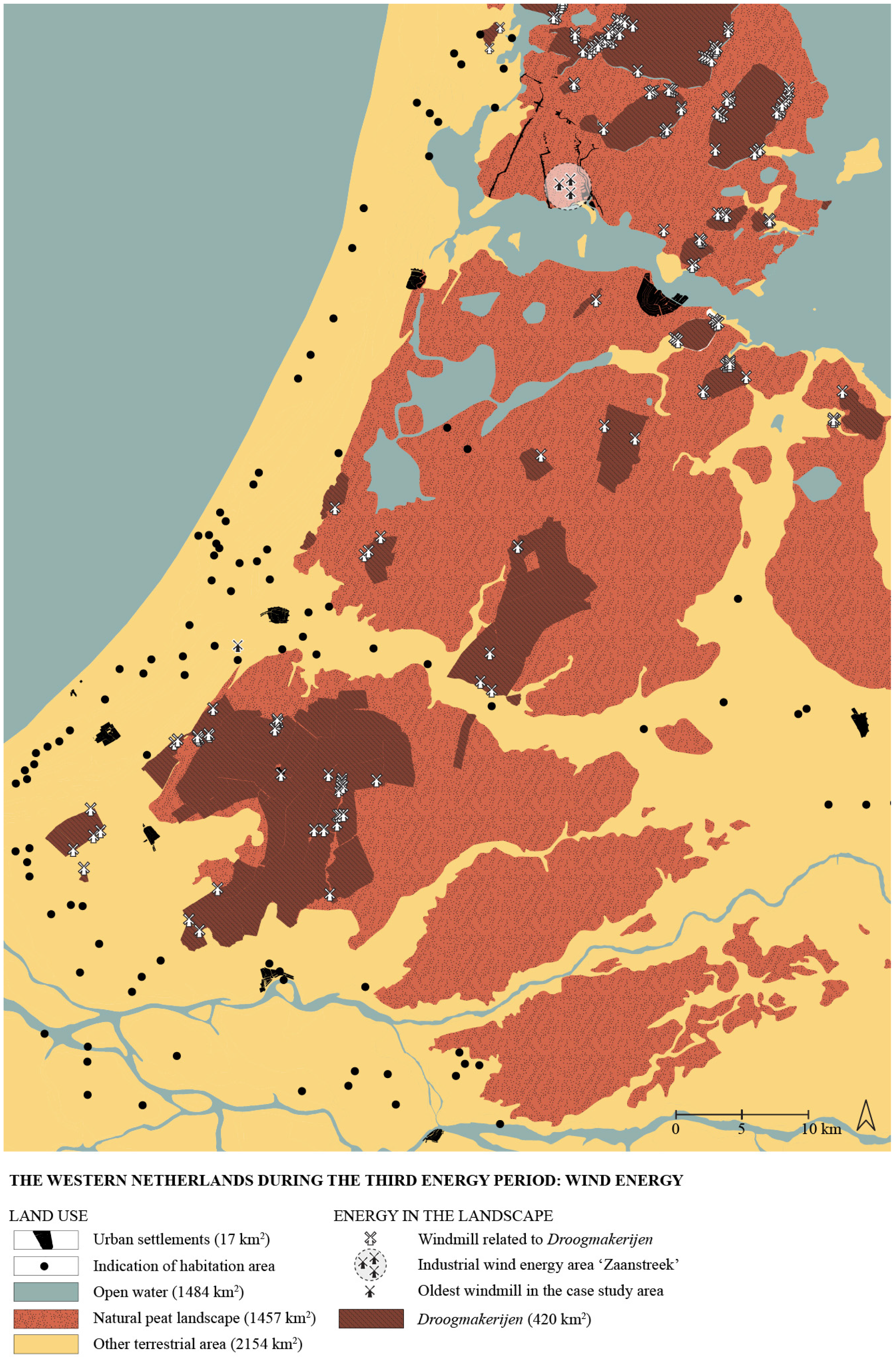
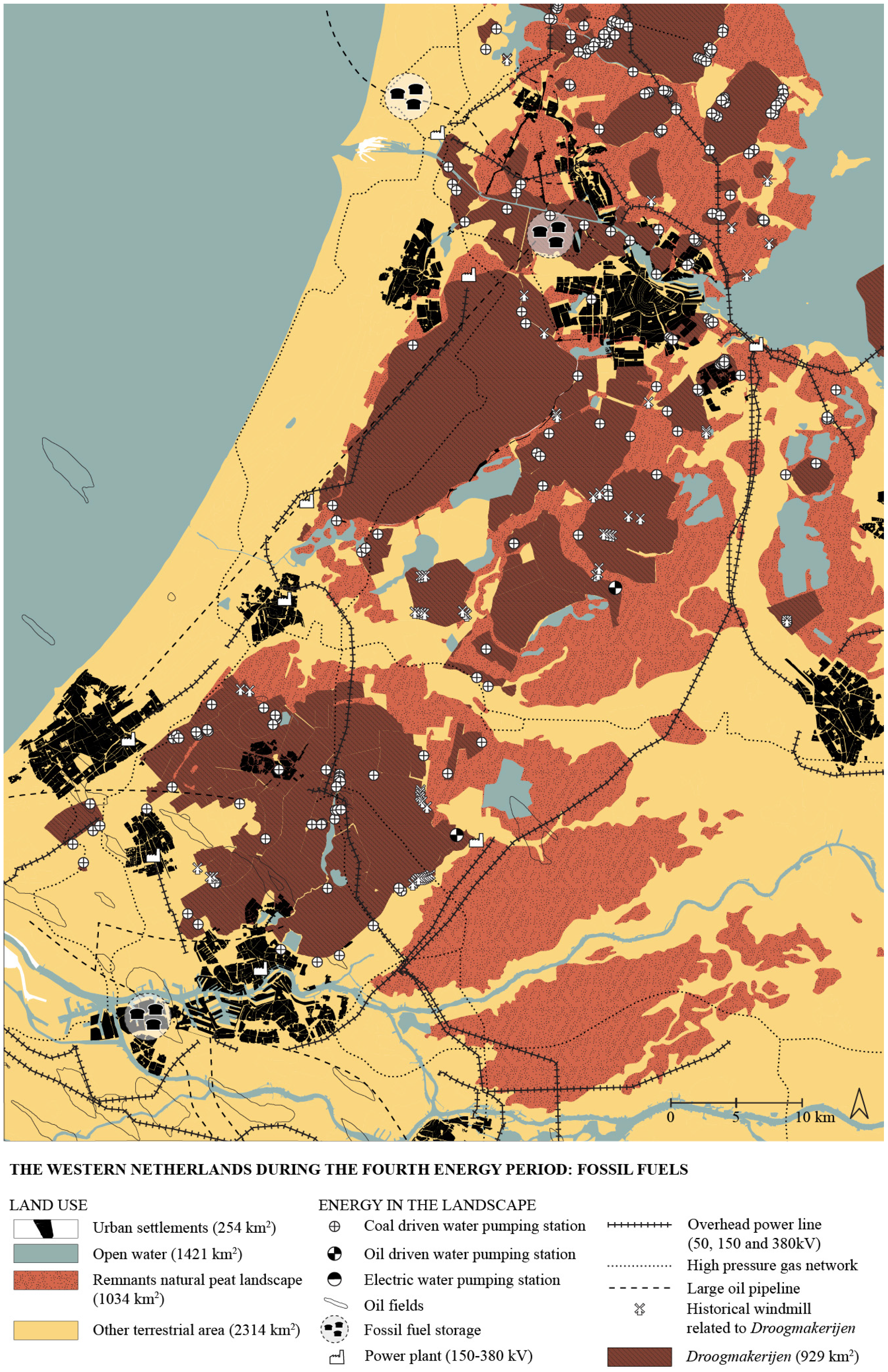
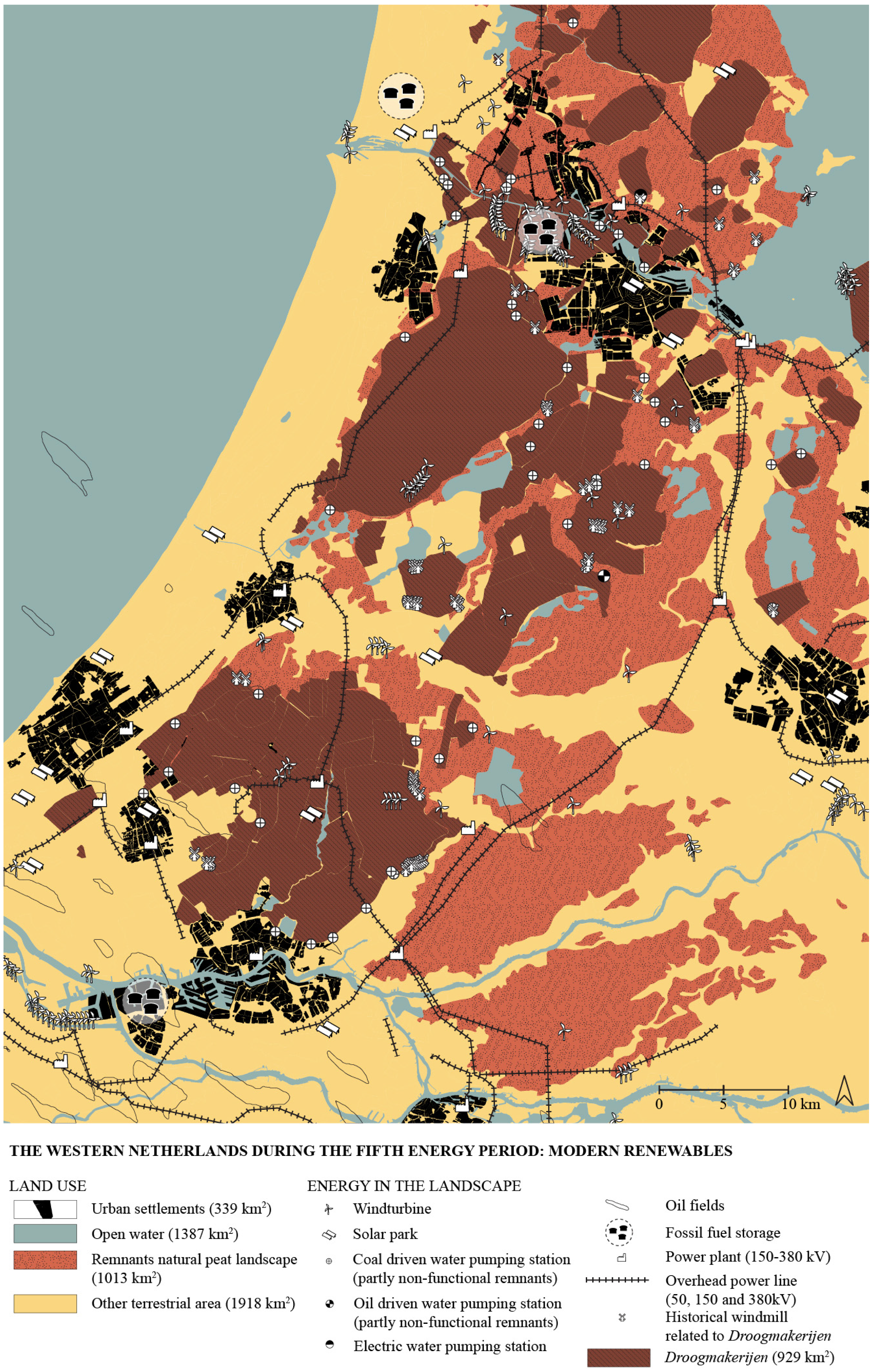
| General Periods in Dutch History | Period 1: Early Middle Ages (Until 1000) | Period 2: Middle Ages (1000–1500) | Period 3: Pre-Industrial Early Modern Time (1500–1800) | Period 4: Modern Time/ Industrialization (1800–2000) | Period 5: Post-Industrial Time (Present-Day) | ||
|---|---|---|---|---|---|---|---|
| Four types of energy economies [6] | Organic economy | Mineral economy | Electricity economy | Sustainable economy | |||
| Three generations of energy landscapes [15] | 1st-generation energy landscapes | 2nd-generation energy landscapes | 3rd-generation energy landscapes | ||||
| Energy periods defined in case study | Period of wood energy | Period of peat energy | Period of wind energy | Period of fossil fuels | Period of modern renewables | ||
| Energy Periods | 1. Period of Wood Energy (<1000) | 2. Period of Peat Energy (1000–1500) | 3. Period of Wind Energy (1500–1800) | 4. Period of Fossil Fuels (1800–2000) | 5. Period of Modern Renewables |
|---|---|---|---|---|---|
| Spatial components of the energy system: Dominant components shown in bold; lines in-between source, conversion and end use represent transport/ transmission infrastructures |  |  |  |  |  |
© 2020 by the authors. Licensee MDPI, Basel, Switzerland. This article is an open access article distributed under the terms and conditions of the Creative Commons Attribution (CC BY) license (http://creativecommons.org/licenses/by/4.0/).
Share and Cite
de Jong, J.; Stremke, S. Evolution of Energy Landscapes: A Regional Case Study in the Western Netherlands. Sustainability 2020, 12, 4554. https://doi.org/10.3390/su12114554
de Jong J, Stremke S. Evolution of Energy Landscapes: A Regional Case Study in the Western Netherlands. Sustainability. 2020; 12(11):4554. https://doi.org/10.3390/su12114554
Chicago/Turabian Stylede Jong, Jolanda, and Sven Stremke. 2020. "Evolution of Energy Landscapes: A Regional Case Study in the Western Netherlands" Sustainability 12, no. 11: 4554. https://doi.org/10.3390/su12114554
APA Stylede Jong, J., & Stremke, S. (2020). Evolution of Energy Landscapes: A Regional Case Study in the Western Netherlands. Sustainability, 12(11), 4554. https://doi.org/10.3390/su12114554





